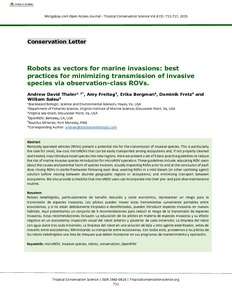| dc.contributor.author | Thaler, Andrew David | |
| dc.contributor.author | Freitag, Amy | |
| dc.contributor.author | Bergman, Erika | |
| dc.contributor.author | Fretz, Dominik | |
| dc.contributor.author | Saleu, William | |
| dc.date.accessioned | 2018-06-25T21:11:54Z | |
| dc.date.available | 2018-06-25T21:11:54Z | |
| dc.date.issued | 2015 | |
| dc.identifier.citation | Thaler, A. D.; Freitag, A.; Bergman, E.; Fretz, D. and Saleu, W. (2015) Robots as vectors for marine invasions: best practices for minimizing transmission of invasive species via observation-class ROVs. Tropical Conservation Science, 8(3), pp.711-717. DOI: http://dx.doi.org/10.25607/OBP-23 | en_US |
| dc.identifier.issn | 1940-082 | |
| dc.identifier.uri | http://hdl.handle.net/11329/437 | |
| dc.identifier.uri | http://dx.doi.org/10.25607/OBP-23 | |
| dc.description.abstract | Remotely operated vehicles (ROVs) present a potential risk for the transmission of invasive species. This is particularly
the case for small, low-cost microROVs that can be easily transported among ecosystems and, if not properly cleaned
and treated, may introduce novel species into new regions. Here we present a set of 5 best-practice guidelines to reduce
the risk of marine invasive species introduction for microROV operators. These guidelines include: educating ROV users
about the causes and potential harm of species invasion; visually inspecting ROVs prior to and at the conclusion of each
dive; rinsing ROVs in sterile freshwater following each dive; washing ROVs in a mild bleach (or other sanitizing agent)
solution before moving between discrete geographic regions or ecosystems; and minimizing transport between
ecosystems. We also provide a checklist that microROV users can incorporate into their pre-and post
-dive maintenance routine. | en_US |
| dc.language.iso | en | en_US |
| dc.subject.other | ROVs | en_US |
| dc.subject.other | Remotely operated vehicle | en_US |
| dc.subject.other | MicroROV | en_US |
| dc.subject.other | Invasive species | en_US |
| dc.title | Robots as vectors for marine invasions: best practices for minimizing transmission of invasive species via observation-class ROVs. | en_US |
| dc.type | Journal Contribution | en_US |
| dc.description.refereed | Refereed | en_US |
| dc.format.pagerange | pp.711-717 | en_US |
| dc.subject.parameterDiscipline | Parameter Discipline::Biological oceanography | en_US |
| dc.description.abstractOtherLang | Robots teledirigidos, particularmente de tamaño reducido y coste económico, representan un riesgo para la
transmisión de especies invasoras. Los pilotos pueden mover estas herramientas sumamente portables entre
ecosistemas, y si no están debidamente limpiados e desinfectados, pueden introducir especies invasoras en nuevos
hábitats. Aquí presentamos un conjunto
de 5 recomendaciones para reducir el riesgo de la transmisión de especies
invasoras. Estas recomendaciones incluyen: La educación de los pilotos en materia de especies invasoras y su efecto
negativo en un ecosistema; Inspección visual del robot anterior y
posterior de cada inmersión; La limpieza del robot
con agua dulce tras cada inmersión; La limpieza del robot en una solución de lejía u otro agente esterilizador, antes de
moverlo entre ecosistemas; Minimizando su transporte entre ecosistemas. Con todos e
sto, proveemos a los pilotos de
los robots teledirigidos una lista de chequeo que deben incorporar en sus programas de mantenimiento y operación | en_US |
| dc.bibliographicCitation.title | Tropical Conservation Science | en_US |
| dc.bibliographicCitation.volume | 8 | en_US |
| dc.bibliographicCitation.issue | 3 | en_US |
| dc.description.sdg | 14.2 | en_US |
| dc.description.maturitylevel | TRL 5 System/subsystem/component validation in relevant environment | en_US |
| dc.description.bptype | Best Practice | en_US |
| dc.description.bptype | Guide | en_US |
| obps.contact.contactemail | andrew@blackbeardbiologic.com | |
| obps.resourceurl.publisher | http://journals.sagepub.com/doi/pdf/10.1177/194008291500800308 | en_US |
 Repository of community practices in Ocean Research, Applications and Data/Information Management
Repository of community practices in Ocean Research, Applications and Data/Information Management
